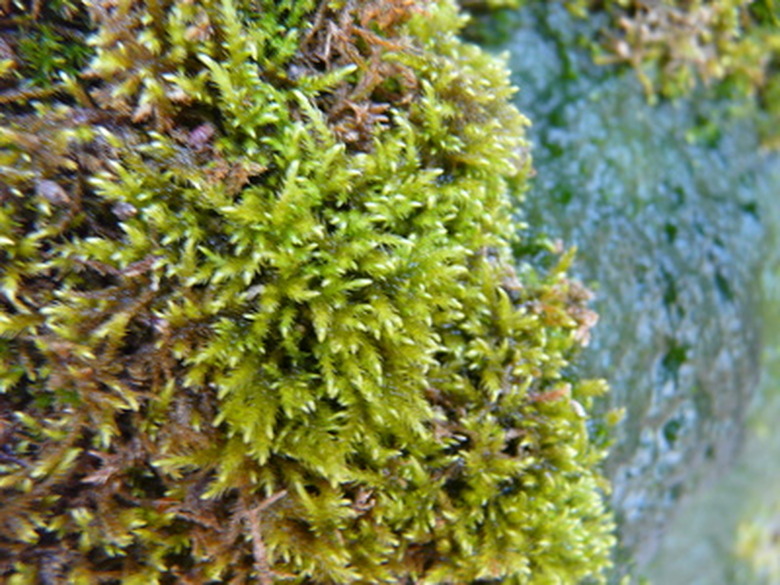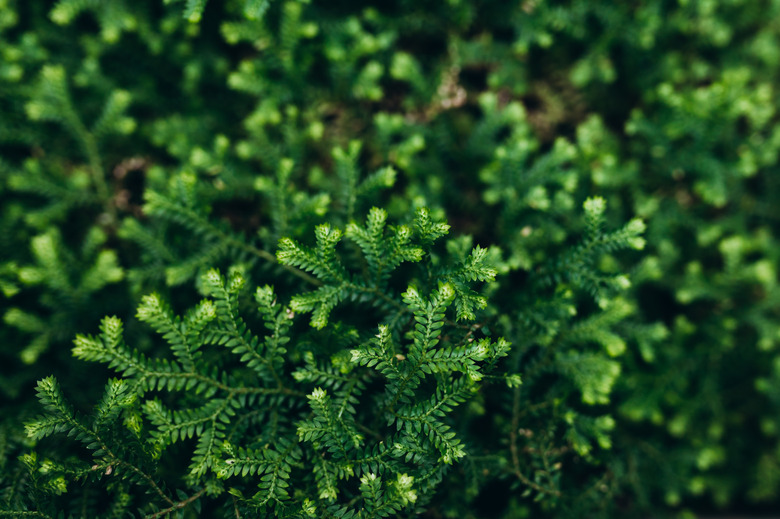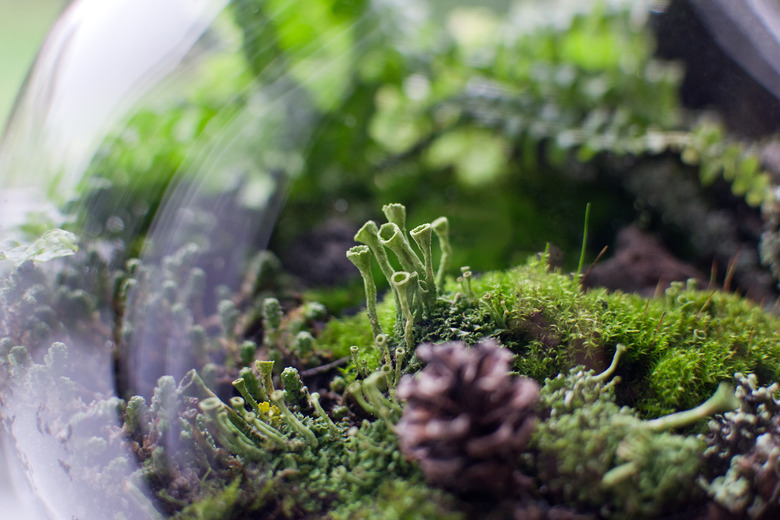How To Grow Moss In A Terrarium
Growing moss in a terrarium is a beautiful, low-maintenance way to bring a touch of the outdoors into your indoor space. Terrariums are enclosed containers of clear glass or plastic used for growing plants that prefer a high-humidity environment. Moss grows best in a very moist environment, so it makes an excellent option for terrarium-growing.
Although creating a moss terrarium is easy to do, setting it up takes careful planning and labor to ensure that the right growing conditions are created. If the balance of soil, substrate and moisture is wrong, then the plants can rot and die.
Tip
There are several types of terrarium-like growing containers, including thuidium, vivarium and paludarium, but a terrarium used specifically to grow moss is called a mossarium.
Choosing the Best Terrarium Moss Types
Choosing the right type of moss will help make your terrarium a successful endeavor. As a general rule, it is best to grow terrestrial moss that was propagated under controlled conditions in a nursery rather than moss that has been harvested directly from a natural environment, because forest moss may harbor bacteria and fungi.
- Irish moss varieties, such as peacock moss (Selaginella uncinata, zones 6a to 10b), are especially pretty, so they make a good addition to terrariums. Peacock moss produces ferny, bluish fronds that contrast well with yellowish or chartreuse foliage.
- Trailing Irish moss (Selaginella kraussiana, zones 11a to 12b) also makes a good addition to terrariums. It comes in several different cultivars, such as the golden-colored Aurea (Selaginella kraussiana 'Aurea') and Variegata (Selaginella kraussiana 'Variegata'), which has green and white foliage.
- One common moss variety for terrarium cultivation is fan club moss (Lycopodium digitatum or Diphasiastrum digitatum), which grows best in USDA zones 4a to 7b. It needs a very large terrarium container that provides at least 1 gallon of soil volume to accommodate its size, which can range from 5 to 10 inches in height with a 1-foot spread.
- Cushion moss (Leucobryum albidum) is a type of moss noted for its rounded, clumping growth habit. It grows outdoors in USDA plant hardiness zones 4 to 9, but it also makes an excellent addition to terrariums because of its velvety texture and bright green color.
One plant that you should avoid growing in your moss terrarium is angel's tears (Soleirolia soleirolii, zones 9a to 11b). It is sometimes sold under the common name of Irish moss, but it is not a true moss and will quickly overtake other plants growing inside a terrarium.
Tip
Live moss is sold as small specimens similar to sod plugs, or you can purchase a preserved moss powder to mix a slurry that can be spread over the soil inside the terrarium to grow new plants.
Building Your Terrarium
Terrarium kits are widely available online and in some specialty stores, but you can also make one DIY-style. Choosing the right container, layering the soil and substrate and planting the moss in the right way will get your terrarium off to a good start.
Choosing a Container
One of the most important steps when learning how to make a moss terrarium is choosing the right container. Any large glass container can be used to build a moss terrarium, but some containers are better than others.
- Moss needs a closed terrarium because it grows best in a very humid ecosystem. Open containers and dish gardens do not hold enough humidity.
- An empty fish tank larger than 10 gallons works best for creating a terrarium, because it has a wide, open top that will allow you to reach inside—but it also comes with a lid to hold in humidity.
- A large jar can also be used to create a smaller terrarium; just be sure to use a mesh lid to allow air to circulate inside.
Layering the Soil
Terrariums do not have drainage holes in the base, so you must create a drainage layer at the bottom of the container to maintain a healthy moisture balance in the soil.
1. Spread a 2-inch-thick layer of gravel, perlite or small pebbles along the bottom of the container. 2. Cover the drainage layer with a 1/4-inch-thick layer of activated or horticultural charcoal. Charcoal will help control soil odor and will help with drainage, but it is an optional step. 3. Add a 1- to 4-inch-thick layer of light, organically rich soil over the charcoal layer. A commercial soil mix containing peat moss, sphagnum and perlite is a good choice, as is a mix of half potting soil and half peat moss.
Larger terrariums allow for greater creativity with your soil layer, because you can create hills and dips in the soil layer to mimic natural landforms.
Planting Your Moss
Planting moss is simple to do. It does not require you to dig a hole; just prepare the soil by moistening it using a spray bottle just prior to planting.
- Remove the moss plugs from their containers. Set them where you'd like to plant them. Keep in mind the mature size of the moss species and space the plugs accordingly.
- Press the roots against the surface of the soil inside the terrarium. Press just hard enough to create good contact between the moss and the soil.
It is a good idea to develop a plan before planting moss in your terrarium. Imagine how the different types of moss that you are growing will look at their mature size and then sketch out a planting plan.
- As a general rule, it is a good idea to plant taller types of moss toward the back of the terrarium so that they don't block the view. However, adding taller mosses toward the front corners of the terrarium can also enhance or frame the view inside.
- Spread low-growing moss along the entire bottom of the terrarium. Sheet moss (Hypnum cupresiforme) is a good choice for this, because it is a terrestrial moss that forms a dense, velvety carpet.
- Eye-catching moss varieties can be planted toward the middle of the terrarium as a centerpiece, or they can be tucked away in the corners to add a pop of color.
Tip
Add terrarium decor, such as stones, sticks or small statuary, after planting your moss.
Growing Moss in a Terrarium
Growing moss in a terrarium takes little effort, but the terrarium must be positioned in the right place to prevent damage to the moss inside. Strong, direct sunlight will scorch and kill moss, especially when it is grown inside a glass container.
Position the terrarium where it will receive bright, indirect light. Place the terrarium near a window with eastern, northern or western exposure. Do not position the terrarium near a south-facing window unless it is shaded all day or if you are growing sun-tolerant moss, such as peacock moss.
Moss dries out quickly, so regular misting is a good idea. Check the moisture level inside your terrarium every few weeks. A well-balanced terrarium will only need a light misting of water every four to six months. Use distilled water or rainwater for moss.
Tip
Overwatering can cause root problems even in moisture-loving plants, such as moss. Do not water if there is visible water in the pebbly substrate.
References
- University of Missouri Extension: Terrariums
- Tulane University Outdoor Adventures: Bring the Great Outdoors Inside – Native Terrarium DIY
- Iowa State University Extension and Outreach: How to Create and Care for a Terrarium
- Logee's Plants for Home & Garden: Cultural Information – Selaginella
- North Carolina State University Cooperative Extension: Selaginella uncinata
- North Carolina State University Cooperative Extension: Selaginella kraussiana
- North Carolina State University Cooperative Extension: Soleirolia soleirolii
- National Gardening Association: Fan Clubmoss


